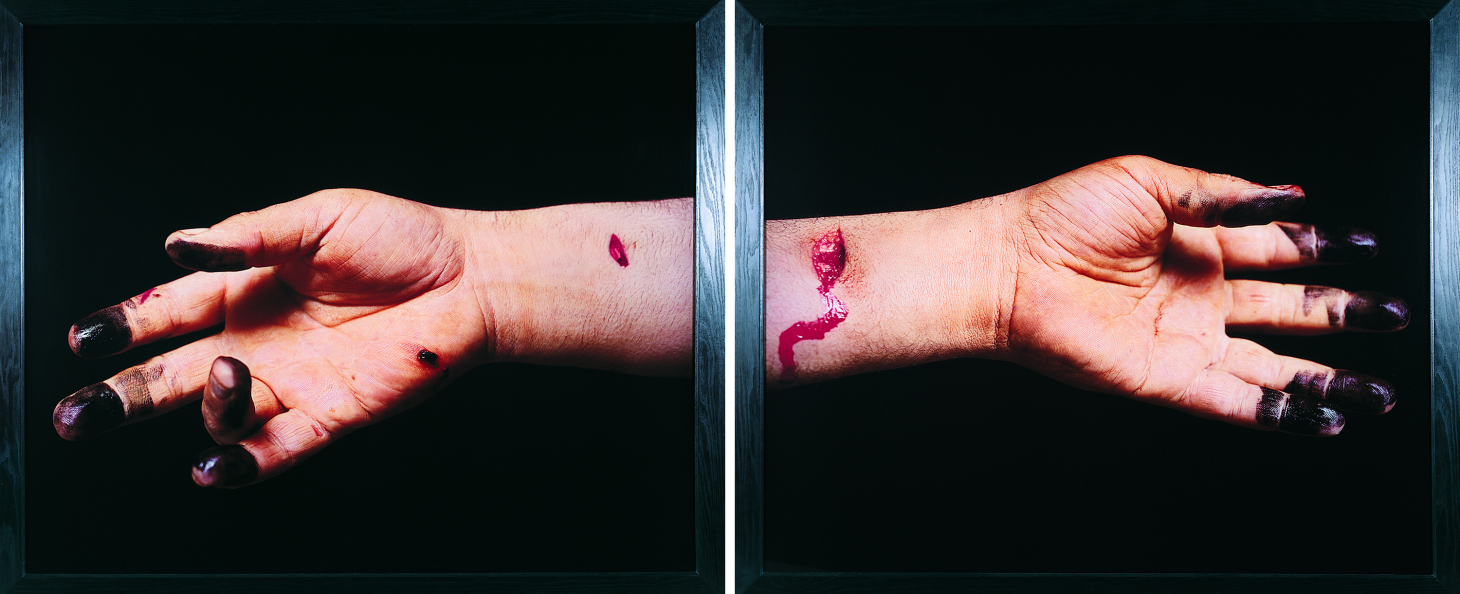Published in Hyperallergic September 25, 2019. ︎
A Contemporary Approach to Religious Symbols
CHICAGO — He suffered, was crucified, died, and was buried; he descended to hell. He rose again from the dead… (paraphrased from Apostle’s Creed) Though the words and their languages differ, the song and dance is nearly the same — Christ suffered as do we. According to the universalizing Christian myth, Jesus is a martyr, representative of our collective suffering and trauma. Even as each successive generation is raised without firm religious groundings, images of Christ still make their way into contemporary art and media as artists cite the Biblical roots of the so-called Western cannon. Addressing often racialized violence, collective trauma, and ranging notions of faith — whether they be religious or spiritual — comprise the basis for the Museum of Contemporary Art Chicago’s small yet mighty exhibition, Fragments of a Crucifixion.
The exhibition is small, tucked away behind central staircases leading to the Virgil Abloh show upstairs and a theater below. Perhaps due to its size (9 x 7’), Titus Kaphar’s 2016 painting, Ascension, is presented on the exhibition space’s outer wall. The hollowed silhouette of a basketball player mid-dunk is filled with a reimagining of Rogier van der Weyden’s The Descent from the Cross, one of the most well-recognized visual depictions of the crucifixion in (art) history. Placed on the opposite side of the wall from the exhibition’s namesake, Paul Pfeiffer’s 1999 video work Fragments of Crucifixion (After Francis Bacon), also features an image of a professional basketball player, crying out after, I assume, making a slam dunk. These two seconds are set on a silent endless loop, infinitely rewinding a moment of joyful outcry, scaled to only 3 inches wide via a tiny projection. Pfieifer, in an interview with curator Chanon Kenji Praepipatmongkol, notes the varied meaning: “the scream continues infinitely, so it becomes ambiguous as to whether it’s a scream of pleasure or a scream of pain.” In its endless loop and affective outburst, Pfeiffer’s work also points to the repetitive nature of religious and spiritual acts. Together, the two works explicitly highlight the grim irony of the Black body being both a profitable commodity in the realm of professional sports, and one of the most targeted by law enforcement and society — both dynamics of which leave the body in ruins. Images of Colin Kaepernick’s 2016 kneel come to mind, along with the financial and professional repercussions that followed.
Across the way, four photographs from Ana Mendieta’s Silueta series are exhibited. The images, all untitled, depict shadowed traces and outlines of Mendieta’s body. In one, a hallowed and wooden figure — like a scarecrow with no stuffing — burns on an elevated stake. In another, an outline of a body has been dug into the earth, as if to fill with her body, but instead, the ‘grave’ has been filled with flowers and framed with greenery. Mendieta created these outlines of her own body with varied materials — paint, blood, flowers, branches, shells, sand — and often asked friends or fellow artists to aid in documenting these acts. Some images, like the fiery, engulfed form, are shocking in their blunt delivery and violent suggestions (though no explicitly violent images are captured). All point to something lost.
In making this series, Mendieta drew inspiration from Indigenous goddess figures, and spiritual practices of both her native Cuba (specifically, Santería, or Regla de Ocha, which originated there) and those of Mexico where she made the majority of these works. In their original intent, these images of bodily traces are not references to the crucifixion, but put within this context, the shadows inevitably beg associations. Their inclusion here highlights the hybrid nature of Santeria and other religions prevalent throughout the Americas due to Spanish colonialism. This hybridity highlights the range of just who and what Christ’s crucifixion represents, and further, who may use these images.
Explicit acts of violence, like those Mendieta alludes to, are also reflected across the way in Andres Serrano’s Untitled (Knifed to Death I and II), a massive diptych in which each photograph depicts the punctured forearms and hands of a stabbing victim lying in a temporary resting place; the artist was granted access to a morgue to photograph victims of violence on the condition that he keep their identities anonymous. The wounds, indentions on the wrists caked with dried blood, recall the wounds Jesus displayed to Doubting Thomas.
We humans are known to make martyrs of our lost and harmed. In Adrian Piper’s 2013 Imagine [Trayvon Martin] — which features an image of a target imposed over Martin’s — and Jason Lazarus’s photograph, Standing at the Grave of Emmett Till, day of exhumation, June 1st, 2005 (Alsip, IL), associations to the collective (and familial) mourning of lost Black lives are inevitable and intentional. Presented in Chicago — where city Police Officer Jason Van Dyke was indicted earlier this year for the murder of Laquan McDonald, and where community activists continue rallying against the expansion of policing in Black and brown communities — the struggles against imposed state and societal violence immediately come to mind.
Highlighting both the place of the martyr within contemporary discussions of collective mourning and the often prevalent searches for religious and spiritual guidance, Praepipatmongkol notes, “contemporary art is not so secular a realm that religious and spiritual narratives cannot penetrate it.” Or, more simply put, art mirrors the values of those who make it. The works in this exhibition highlight moments of mourning, but also thankfully, joyful moments of faith and collectivity that continue in the face of traumas. The importance of faith, both individually and commonly, remains visible in more ways than we expect.



